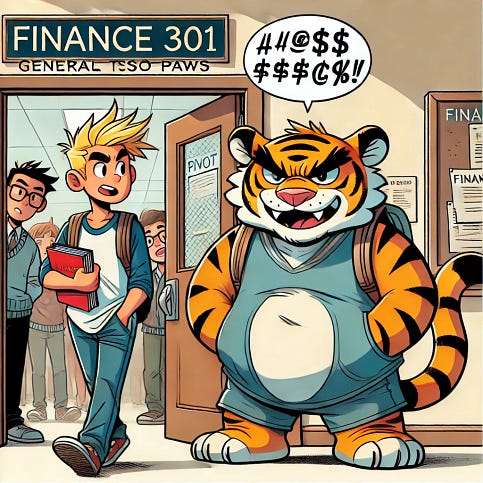You are a free subscriber to Me and the Money Printer. To upgrade to paid and receive the daily Capital Wave Report - which features our Red-Green market signals, subscribe here. A reminder: Our signal went negative twice last week and remains red… Stay patient in this environment, as markets are under severe stress. Money is still chasing the AI trade where it can, but the rest of the market is facing incredible pressure due to the very concerns we raised in September about SOFR and repo. We’re in this now… Dear Fellow Traveler: Greetings from the big counter in my kitchen. Since I work from home… I eat lunch here. But I’ve noticed that the pile of plates caused by me… pile up… So, I’ve gone the Amazon route: paper plates and plastic forks. Now, my wife will tell you that I’m hurting the environment and wasting money… But I counter… the amount of electricity we use to power this machine once a day, combined with the water use, combined with the cost of electricity, combined with the fact that I can light this used paper plate on fire in a fire pit… I’ll bet I’m saving the environment… AND money… This is good innovation… What’s bad innovation? Oh… where to start… The ETF Extraction MachineLet me tell you about the most brilliantly disguised extraction operation in modern finance. It’s not crypto ponzi schemes. It’s not meme stock pump-and-dumps. It’s not even SPAC celebrity cash grabs. I’m talking about ETFs… or Exchange Traded Funds… I’m really focused on how they’ve convinced everyone they’re the good guys while building the most scalable fee-harvesting machine in financial history. It started like this… Wall Street figured out they could make more money by NOT trying to beat the market than by actually trying to beat it. Think about that for a second. You’re a finance bro with an MBA and burning ambition. Do you: A) Start a hedge fund, stress about stock picks, and risk blowing up when you’re inevitably wrong? B) Launch an ETF, buy everything, never be wrong about anything, and collect fees forever? The smart money picked B. And now they manage over $15.1 trillion while doing practically nothing compared to the work of more active managers… The Beautiful Math of Doing Nothing (Almost)Let’s run the real numbers on this operation. You launch an S&P 500 ETF. Your job: buy 500 stocks in the exact proportions they already exist. That’s it. Take the summer off… An intern with a spreadsheet could handle the strategy during a sneezing fit... Sure, there’s operational work… You have to manage cash flows, handle redemptions, and maybe discuss regulatory compliance. But compared to actually trying to beat the market? You’re running a banana stand instead of attempting rocket science. You charge 0.29% in fees. Sounds almost charitable, right? The Global X S&P 500 Catholic Values ETF (CATH) has $1.08 billion in assets… They generate an annual fee income of almost $3.2 million. For buying everything. For never having an opinion. For never being wrong because you’re never trying to be right. Now, their costs are real - technology, compliance, and staff. But they’re largely fixed. Whether a manager has $1 billion or $400 billion, they still need basically the same infrastructure. This means every additional billion generates revenue at nearly pure margin. They’ve built a machine that prints money proportional to how much money people give them, so they don't have to think about money. It’s “financial genius” disguised as humility. The Hidden Costs Nobody Talks AboutBut here’s what they don’t tell you about this “low-cost” revolution… Those cheap expense ratios? That’s just the cover charge. As an investor, you’re also paying bid-ask spreads every time you trade. You pay creation and redemption costs that get buried in tracking error. There is securities lending revenue that goes to the provider, not you. Trading costs during rebalancing that mysteriously don’t show up in the expense ratio. Add it all up, and your “virtually free” index fund might cost a lot more… Still cheap! But not nearly as cheap as advertised. The providers have perfected the art of fee invisibility. They’ve hidden costs in the plumbing while marketing themselves as practically free. The Network Effect TrapHere’s where it gets really brilliant. The more money that flows into ETFs, the more it makes sense for everyone else to pile in. Not because it’s necessarily the best strategy, but because everyone else is already doing it. ETF money flows in leads to rising stocks, which leads to “attractive performance,” which leads to more money flowing in… It’s a self-licking ice cream cone. But what happens when this goes in reverse? When everyone tries to sell at once? Research shows that heavy passive ownership reduces liquidity and increases volatility during stress periods. The very thing that’s supposed to make markets more stable might be making them more fragile. You’re not just buying diversification. You’re buying into a massive coordination game where everyone assumes everyone else will keep playing forever. The Product Multiplication ScamOnce you’ve got people convinced that passive is superior, you can slice and dice the same basic exposure into infinite variations:
That Catholic Values ETF has a 0.29% expense ratio… compared to the 0.09% on the SPY. There’s not much of a difference in the portfolio… The most Catholic thing about that Catholic Values ETF might be that Home Depot is a major holding. And Jesus was a carpenter. So there’s that spiritual connection to the construction industry. Each variation targets different investor biases while delivering essentially the same underlying exposure. More products, more fees, more ways to slice the same pie. You’ve convinced people they need 47 different flavors of vanilla. The Consolidation EndgameThen there’s the real power behind this… The top three ETF providers now control about 75% of ETF assets. That gives them voting control over massive chunks of corporate America. BlackRock, Vanguard, and State Street are now the largest shareholders in most major corporations. Not because they picked winners. Because they bought everything and got so big that they accidentally became the shadow government of Big Business. They’re not trying to pick the best companies. They’re trying to gather the most assets. And coincidentally, they now get to vote on executive compensation, board composition, and corporate strategy for most of the economy. That’s not market capitalism. That’s asset manager feudalism. The Margin Compression LieThe industry loves to brag about driving fees down to nearly zero. What they don’t mention is that ultra-low fees are a loss leader. They’ll charge 0.09% on the S&P 500 to get you in the door, then cross-sell you into higher-fee specialty products. Or they’ll make up the revenue through securities lending, trading spreads, and ecosystem monetization. The “fee war” is marketing theater. The real business model is to gather assets at any cost, then find creative ways to monetize them. What’s Really Happening Here?ETF providers have pulled off the greatest marketing coup in finance history. They’ve convinced everyone that:
They’ve turned the basic investment strategy of “buy everything” into a $15 trillion industry by making it sound like rocket science and moral virtue combined. The real genius isn’t providing superior returns. It’s convincing millions of people to pay fees for a strategy that requires no skill, generates no alpha, and concentrates enormous power in the hands of a few giant asset managers. All while extracting fees and pretending they’re doing God’s Work. Same as it ever was… Please do me a favor and share this with anyone who relies heavily on passive investing… Stay positive, Garrett Baldwin PS: A Reminder… Postcards return in a few weeks… sign up here for free. About Me and the Money Printer Me and the Money Printer is a daily publication covering the financial markets through three critical equations. We track liquidity (money in the financial system), momentum (where money is moving in the system), and insider buying (where Smart Money at companies is moving their money). Combining these elements with a deep understanding of central banking and how the global system works has allowed us to navigate financial cycles and boost our probability of success as investors and traders. This insight is based on roughly 17 years of intensive academic work at four universities, extensive collaboration with market experts, and the joy of trial and error in research. You can take a free look at our worldview and thesis right here. Disclaimer Nothing in this email should be considered personalized financial advice. While we may answer your general customer questions, we are not licensed under securities laws to guide your investment situation. Do not consider any communication between you and Florida Republic employees as financial advice. The communication in this letter is for information and educational purposes unless otherwise strictly worded as a recommendation. Model portfolios are tracked to showcase a variety of academic, fundamental, and technical tools, and insight is provided to help readers gain knowledge and experience. Readers should not trade if they cannot handle a loss and should not trade more than they can afford to lose. There are large amounts of risk in the equity markets. Consider consulting with a professional before making decisions with your money. |
Home
› Uncategorized


Post a Comment
Post a Comment